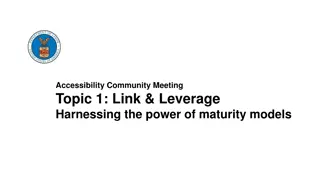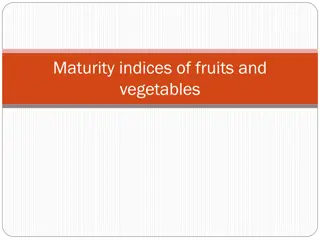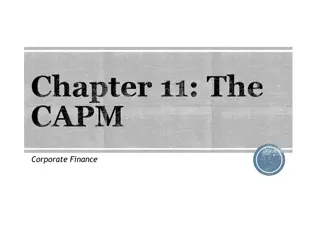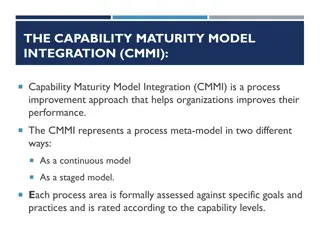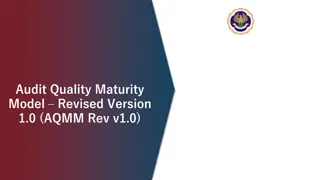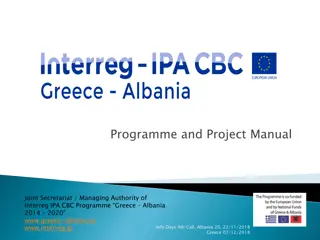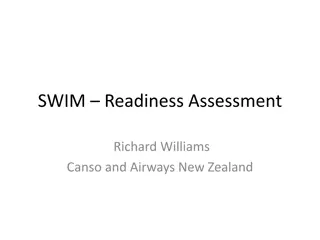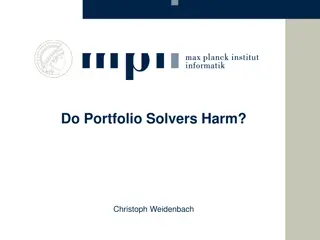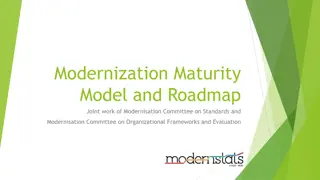Portfolio Programme and Project Management Maturity Model
A comprehensive overview of the P3M3TM model and other maturity models in the project management field, including benchmarks, self-assessment tests, and the scope of model refresh. Learn about the significance of maturity levels, benchmarking, and utilizing different models for organizational growth and improvement.
Download Presentation

Please find below an Image/Link to download the presentation.
The content on the website is provided AS IS for your information and personal use only. It may not be sold, licensed, or shared on other websites without obtaining consent from the author.If you encounter any issues during the download, it is possible that the publisher has removed the file from their server.
You are allowed to download the files provided on this website for personal or commercial use, subject to the condition that they are used lawfully. All files are the property of their respective owners.
The content on the website is provided AS IS for your information and personal use only. It may not be sold, licensed, or shared on other websites without obtaining consent from the author.
E N D
Presentation Transcript
Portfolio Programme and Project Management Maturity Model (P3M3TM) Alan Harpham, The APM Group BPUG Workshops at Project Challenge are supported by: Slide number 1 1
What is a Benchmark or Maturity Model? Benchmarking Comparing processes Benchmarks - metrics Maturity Models Maturity levels OGC Portfolio, Programme and Project Management Maturity Model (P3M3TM) Version 1 Current Re-write will be Version 2 Self-assessment tests APMG Maturity Level Assessment Process Slide number 2 2
Other Maturity Models Software Engineering Institute Carnegie Mellon University CMMI Organizational Project Management Maturity Model (OPM3)TM - PMI Private Organisations models e.g. some Management Consultancies Portfolio, Programme and Project Management Maturity Model P3M3TM Office of Government Commerce UK developed from SEI model Slide number 3 3
OGC Context PRINCE2: 2009 project to refresh PRINCE2TM Due Q1 2009 P3OTM portfolio, programme and project support office Completely new publication Due September 2008 P3M3TM Scope from feedback and OGC reference group Mandate issued by OGC Mike Acaster - OGC Slide number 4 4
Scope of refresh Restructuring of the model to improve accessibility and usability Addition or deletion of content in/of the model to align it with the refreshed MSP, M_o_R, OGC Gateway and revised portfolio management guidance Addition of relevant content to align the model with any emerging OGC procurement guidance New introduction and supporting guidance on use of the model Creation of one or more self assessment questionnaires Maintain existing high-level framework for continuity Slide number 5 5
Requirement Introduction essentially what it is and the business case for using it Separation of Portfolio, Programme and Project management elements so these can be used independently of each other Separation (or the means to separate) the model into themes or topics One or more self assessment questionnaires (could be based on Portfolio, Programme or Project management elements; or one per theme) Instructions on use of self assessments (including their limitations) Information on next steps (pointing to routes for consultancy advice, facilitated assessments or self improvement options) References (including cross references to relevant procurement capability guidance) Acknowledgments Glossary Slide number 6 6
OGCs P3M3: The Standard 5 Levels Project Management Level 1 Initial Process Level 2 Repeatable Process Level 3 Defined Process Level 4 Managed Process Level 5 Optimised Process Does the organisation s Board recognise programmes and projects and run an informal list of its investments in programmes and projects? (There may be no formal tracking and reporting process.) Does the organisation ensure that each programme and/or project in its portfolio is run with its own processes and procedures to a minimum specified standard? (There may be limited consistency or co- ordination.) Does the organisation run continuous process improvement with proactive problem and technology management for the portfolio in order to improve its ability to depict performance over time and optimise performance? Does the organisation have its own centrally controlled programme and project processes andcan individual programmes and projects flex within these processes to suit the particular programmes and/or project? And does the organisation have its own portfolio management process? Does the organisation obtain and retain specific management metrics on its whole portfolio of programmes and projects as a means of predicting future performance? Does the organisation assess its capacity to manage programmes and projects and prioritise them accordingly? Slide number 7 7
OGCs P3M3: The Standard 5 Levels Programme Management Level 1 Initial Process Level 2 Repeatable Process Level 3 Defined Process Level 4 Managed Process Level 5 Optimised Process Does the organisation recognise programmes and run them differently to projects? (Programmes may be run informally with no standard process or tracking system.) Does the organisation ensure that each programme is run with its own processes and procedures to a minimum specified standard? (There may be limited consistency or co-ordination between programmes.) Does the organisation have its own centrally controlled programme processes and can individual programmes flex within these processes to suit the particular programme? Does the organisation obtain and retain specific measurements on its programme management performance and run a quality management organisation to better predict future programme outcomes? Does the organisation run continuous process improvement with proactive problem and technology management for programmes in order to improve its ability to depict performance over time and optimise processes? Slide number 8 8
OGCs P3M3: The Standard 5 Levels Portfolio Management Level 1 Initial Process Repeatable Process Level 2 Level 3 Defined Process Level 4 Managed Process Level 5 Optimised Process Does the organisation s Board recognise programmes and projects and run an informal list of its investments in programmes and projects? (There may be no formal tracking and reporting process.) Does the organisation ensure that each programme and/or project in its portfolio is run with its own processes and procedures to a minimum specified standard? (There may be limited consistency or co-ordination.) Does the organisation have its own centrally controlled programme and project processes andcan individual programmes and projects flex within these processes to suit the particular programmes and/or project? And does the organisation have its own portfolio management process? Does the organisation obtain and retain specific management metrics on its whole portfolio of programmes and projects as a means of predicting future performance? Does the organisation assess its capacity to manage programmes and projects and prioritise them accordingly? Does the organisation run continuous process improvement with proactive problem and technology management for the portfolio in order to improve its ability to depict performance over time and optimise performance? Slide number 9 9
Rewrite Rod Sowden Lead Author Slide number 10 10
The Team Mike Acaster OGC SRO Alan Harpham APMG Sponsor Rod Sowden Lead Author (Aspire Europe Ltd) Steve Clarke Author (Onemind Management Ltd) David Stuart Hinley Author (Enodatum Ltd) Paul Faulkner Project Manager (APMG) Slide number 11 11
Objectives & Scope Restructure the model to improve accessibility and usability Align the content of the model with the refreshed MSP, M_o_R, OGC Gateway and revised portfolio management guidance Where appropriate align the content of the model with the emerging OGC procurement guidance Develop a new introduction and revise supporting guidance on the use of the model and the self assessment questionnaire The new standard should be able to be used thematically i.e. to establish the maturity of the organisation's processes such as business case, planning, reporting and so on. A model covering portfolio, programme or project management maturity that can also deal with the component themes individually An initial self-assessment questionnaire that can be downloaded via the internet Consistent with original, i.e, investments in assessments will not be lost Slide number 12 12
P3M3 3 models which may be viewed independently Project Programme Portfolio 5 levels of maturity 5 being the highest 7 perspectives which group together a range of key characteristics Attributes that describe the characteristics at each intercept in the model 5 common attributes themes that are common in each perspective and can be found at each level Slide number 13 13
Mgt Control Benefits Mgt Risk Mgt Finance Mgt Org Improve Org Gover nance Res Mgt Level 5 Optimised Level 4 Managed 3 x 35 x Intercepts 5-15 Attributes per model Level 3 Defined Common Attributes Plans Capability Information Stakeholders Quality Level 2 Repeatable Level 1 Recognised Slide number 14 14
How they integrate and overlap PfM3 PgM3 PjM3 Still evolving models need to stand alone as well as interact Slide number 15 15
The 5 Levels Level 1 Recognition undocumented, basic vocabulary (not necessarily aligned or consistent), no guidelines and supporting documentation. Any system is ad-hoc and uncontrolled. Level 2 Repeatable Locally evolved, acknowledged approach, templates, ad-hoc training, islands of expertise, initiatives delivered in isolation, minimal evidence of continual improvement, simple activity based plans, focus may be on start up and initial documentation, evidence of heroes, weak inter working Level 3 Defined Organisational wide consistency, process ownership, standards in place (e.g roles and responsibilities), processes defined with inputs and outputs, central control group, consistent use of tools, guidelines on how to do it, system framework, governance clearly defined, capable staff, configuration system, evidence of Subject Matter Experts, good communications and collaboration, strategic planning links, perceptive approach to management, flexing Level 4 Managed Integration with Corporate governance and functions, accurate information, statistical analysis, competent & qualified staff, assurance in place, business capacity management, exec board level ownership, mentors, process management, strategic planning alignment, approaches reviewed, consistent behaviour, quantitative approach to management, collaboration, adapting Level 5 - Optimised Start, end, route, process optimising, business process ownership, integrated with strategic direction, lessons learned being applied, continual improvement, common good for the organisation, seamless and automatic, sustained, value based behaviour, evidence based management, innovation Slide number 16 16
The 7 perspectives Management Control Lifecycle, stages, gates, tranches, controls, Vision, Blueprint, Outcomes, Business Strategy, Issue management , Configuration management, change control, progress reporting, definition and design, Requirements, define, tracking, ownership, plan, transition Benefits Management Finance Management Risk Management Costs, Business Case, approvals, tracking, Types, breadth, structure, process, rigor, techniques, interventions, opportunities and threats Functional, change management, business performance management, stakeholder engagement, analysis, Communications, consultation and involvement in requirements, idea and proposition management Leadership, Direction, Alignment, stakeholder representation, senior management active engagement and ownership, balance of authority between functional and PPM Roles, reporting lines, assurance, legislative and policy compliance (FOI, H&S), info management controls Organisation Improvement Organisation Governance Resources Capacity, types, procurement, suppliers, skills and experience, control, allocation and deployment Slide number 17 17
The 5 Common Attributes Planning effectively Assesses the availability, use and value of the plans that exists for each perspective, levels of sophistication in their development and ownership Assesses how integrated are stakeholders into the design and decision making process and the quality and sophistication of the communications processes deployed in each Perspective Assesses the quality and accuracy of the information being used for decision making, how this information is stored and catalogued Stakeholder involvement Information & Configuration Management Quality Assesses how effective and valuable the process of review, auditing and assurance are to the organisation, and how these are managed and exploited Assesses how the organisation develops the internal resources to increase their capability and potential over time Capability building Slide number 18 18
Each Perspective at each Level Short paragraph Level of maturity expected for the perspective Description 5-15 bullets would be the norm What characteristics, behaviours, systems etc would we expect to be in place to prove this maturity Attributes Purpose and justification of why this is important Inter relationships with other perspectives and levels Context Slide number 19 19
How it might look Mgt Control Benefits Mgt Risk Mgt Finance Mgt Org Improve Org Gov Res Mgt L 5 L 4 L 3 L 2 L 1 Slide number 20 20
Any Questions: Slide number 21 21
Finally Slide number 22 22
Best Practice User Group for programmes, projects and risks. aims to be the official user group of choice Our mission: To help users adopt, use, share and shape the application of OGC PPM Products www.usergroup.org.uk 0845 0548038 admin@usergroup.org.uk Slide number 23 23




